STRIKE IT RICH
THREE OIL AND GAS STOCKS WITH BIG OPPORTUNITIES

VOL 25 / ISSUE 23 / 15 JUNE 2023 / £4.49 xxxxx NEWS Everything you need to know about the sector and the stocks to buy now LUXURY GOODS







• UK banks’ profit margins under threat as pressure grows to boost rates on savings accounts
• What El Niño means for commodity markets and how to play strong crop prices
• Biotech companies in demand as pharmaceutical companies spend billions on takeovers
• Netflix password sharing crackdown behind recent share price rally
• Gym Group faces macroeconomic headwinds and consumer behaviour shift
New: Whitbread / Next 15

or genuine trend? What you need to know before investing in a thematic ETF


a retrospective lifetime allowance assessment be made once in drawdown?


15 June 2023 | SHARES | 03 Contents 05 NEWS
11 GREAT IDEAS
Updates:
EDITOR’S
FEATURE
RUSS MOULD
24 SECTOR REPORT Is
28 EDUCATION Five key ratios to analyse a stock in
minutes
35 ASK TOM Can
36 PERSONAL FINANCE Why
38 INDEX Shares, funds, ETFs and investment trusts in this issue 22 16 36 15 28 11
DiscoverIE 15
VIEW Are parts of your portfolio not doing well? Here’s why that can be healthy 16
Strike it rich: three oil and gas stocks with big opportunities 22
Reasons why the market could be too pessimistic about oil demand
the post-Covid luxury goods boom coming to an end?
five
31 ETFs Fad
your pension provider will soon warn you about holding too much cash
PersonalFinance:Pensions


Thegoalistohaveamixofuncorrelated assetsandtounderstandthatnot everythingshouldmoveintandemDofoyoueverthinkaboutejectingthepart yourportfoliothatisnotdoingwell? theBycuttingyourlossesyoucouldreinvest proceedsbackintowhatisdoing maywellandyourportfoliowouldlookhealthier.That Thenotbethebestactiontotake.factpartsofyourportfolioarelaggardscould beasignyouhaveahealthymixofuncorrelated assets.Yes,itcanalsomeanyouhavemadebad investmentdecisions,yetitcansignalproper diversificationwhichisagoodthing. timesYouwantinvestmentstodeliveratseparate helpingsothereisalwayssomethinginyourportfolio Investorswiththepursuittogrowyourwealth. oftenlackdiversification,evenifthey putthinktheyalreadyhaveit.Aclassicmistakeisto drivenallyourmoneyintostocksorfundsthatare bythesamefactors.Forexample,someone mighthavetwoactivelymanagedglobalfunds, sharesinApple(AAPL:NASDAQ)andMicrosoft (MSFT:NASDAQ),andacoupleoftechnologyisthemedinvestmenttrustsandtrackerfunds.There ahighchancethatAppleandMicrosoftfeature inalltheglobalandtechfunds,andthatthereis considerablecrossoverelsewhere. diversifying‘Thecommonmistakeistothinkyouarebyowninganumberofdifferentassets andwhentheyareallhighlycorrelatedtoeachother kiddingdeliveratthesametime.Youareactually yourselfthatyouarediversifying–it’s fakediversification,’saysBarryNorris,headof ArgonautCapital. they‘Thisisaproblembecausepeoplewhothink actuallyarediversifyingbyowningdifferentnames justendupinthesamebullmarketrodeo whenallofthosestockswillonlyperformunder allcertainmacroeconomiccircumstances,suchas perceptionsbeinghighlycorrelatedtolowinterestratesor ofgrowthinthetechworld. ‘Thatcrowdingoftenhappenswhenyou’vehada
Arepartsofyourportfolionotdoing well?Here’swhythatcanbehealthy
Editor’sView:DanielCoatsworth

Three important things in this week’s magazine 1 2 3
STRIKERICHIT
bylongbullmarketandpeoplethinktheycandiversify owning10techstocksratherthanone,butthat isthecompleteoppositeofdiversification,’adds Norris. yourTofixtheproblem,oneapproachistospread geographiesmoneyacrossarangeofindustrysectors, andassetclasses.Thatmeanslooking gold,beyondequitiesatareassuchasbonds,property, glamourousinfrastructureandcash.Theymaybeless thanequitiesbuthistorysuggeststhey canprovideballasttoaportfoliooverthelongterm. fallingLastyearwesawtherarephenomenonofbonds infrastructureinunisonwithequities,withpropertyand alsohavingachallengingtime.Cash certainlybenefitedfromrisinginterestratesbut theseotherassetclassesdidnot. yeartaketheviewthat2022wasahighlyunusual muchwithmarketshavingtorapidlyadjusttoa shootingdifferentlandscape,withinterestrates fromrockbottomtoamorenormalised tolevelandtherapidpaceofchangecausedashock assetsthesystem.Thisisstillplayingout,hencewhy likeinfrastructurearecurrentlystruggling,buthopefullytheworstispastus. seeLookbackacrosslongerperiodsandyouwill whenthatbondshavefunctionedasacushion equitiesstruggle,likewisegold,property sun.andcashhavealsohadtheirmomentsinthe eventuallyItseemslogicaltosuggestthesetrendswill return.

Don’t expect everything in your portfolio to rise at the same time
True diversification should see different assets move at different times – everything moving in unison could be a negative sign
Whyyourpensionproviderwill soonwarnyouaboutholdingtoo
Thefinancialregulatorwantspeopleunder50tounderstandthebenefitsofbeing investedinthemarketsNthatewrulesfromtheregulatorwillmean fromDecemberthisyearyouwill getanemailorletterfromyourpension providerifyouhavealotofcashinyourpension. moreThereareafewcriteriayou’llhavetomeet:that than25%ofyourpensionisincash,thatthis thanfigureismorethan£1,000andthatyouaremore whichfiveyearsfromnormalminimumpensionage, is55formostpeople.Yourpensionprovider outwillhavetoassessthiseverythreemonths,sending anotificationifyou’vemetthecriteriaforsixmonths. WHAT’S IN THE LETTER? Yourpensionproviderwilltellyouaboutyourcash levels,provideyouwithacalculationabouthow youinflationiseatingawayatyourcash,andprompt tothinkaboutyourinvestmentsandwhether youneedtomovesomeofthatcashintoother everyassets.Onceithassenttheletteritwilldosoagain 12monthsthatyoumeetthecriteria.
theYoudon’thavetotakeanyactionoffthebackof youremailorletterandyoudon’thavetoreplyto provider–it’smoreintendedasapromptfor theyyoutothinkaboutyourcashlevelsandwhether arerightforyou.HOW MUCH CASH SHOULD YOU HOLD?isThatsparksthenextquestion,howmuchcash We’vetherightamounttohaveinyourpension? previouslytalkedabouttherightlevelsofcashtoholdgenerally buttheparametersare abitdifferentwhenitcomestoyourpension, veryparticularlybecausecashinpensionsdoesn’tearn Everyonemuch,ifany,interest.willusuallyhavesomeoftheirpension incash,tomeetthefeesandchargesfromtheir pensionprovider. sumsButgenerallyit’snotagoodideatohavelarge incash,particularlyoverthelongterm.Here’s isanexample:Apensionpotworth£100,000that worthalways75%investedand25%incashwouldbe £235,500after20years,assumingnofurther
Holding a lot of cash in your pension? You might soon receive an alert under new rules from the financial regulator
The Financial Conduct Authority wants people not yet in retirement to think about the benefits of being invested in the markets
Visit our website for more
articles
Did you know that we publish daily news stories on our website as bonus content? These articles do not appear in the magazine so make sure you keep abreast of market activities by visiting our website on a regular basis.
Over the past week we’ve written a variety of news stories online that do not appear in this magazine, including:
2023.hasenduredamuchmorechallengingtimein profitsWindfalltaxeshavetakenabigbiteoutof andcommoditymarketshavefallenbackas fearsofrecessiondampendemandexpectations. onerousFacingtheprospectofanunstableandmore operatorsfiscalregimeintheUK,NorthSeaarehavingtobroadentheirhorizons. Therearealsosignsofarecoveryinexploration foractivity,whichmeanstherearestillopportunities depressedinvestorsinthesector,particularlygiventhe valuations.However,thesectorremains highriskandprospectiveinvestorsshouldonlybuy sharesinsmalleroilandgascompaniesiftheyare comfortablewithpotentiallylosingmoney.
A CRUCIAL ROLE TO PLAYPoliticalandregulatoryuncertaintyisan undeniablechallengeforthesectorbutthelast18 monthshaveofferedareminderoftheneedfor fromenergysecurityalongsideagradualtransitionaway Evenfossilfuels. sanctionediffewernewprojectsaregoingtobeinthefuture,existingoilandgasfields tostillrequirecarefulstewardshipandthereneeds integratedbeahealthyindependentsectorbeyondthebig energycompanies. issuesInthisarticlewediveintosomeofthebig crunchingfacingtheindustry,dosomenumber performerstoidentifythebestandworst andthehighestdividendyields buyonofferaswellasidentifyingthreestocksto now.
There are plenty of reasons to stay optimistic about the oil and gas sector, despite weaker commodity prices this year


We look at the space in this week’s main feature and pick three stocks to buy now
Investors beware: Vodafone shares have tanked to a 27-year low, here’s why
CORRECTION: We incorrectly stated in the 8 June 2023 edition of Shares that Hipgnosis Songs Fund was backed by Blackstone and had bought Justin Bieber’s music publishing rights. Blackstone does not have a shareholding in Hipgnosis Songs Fund. The Bieber deal was struck by Hipgnosis Songs Capital, a private venture between Hipgnosis Songs Fund’s investment adviser and Blackstone.

04 | SHARES | 15 June 2023 Contents
36 SHARES 15Jube2023
much
16 SHARES 27April2023
cash
THREE OIL AND GAS STOCKS WITH OPPORTUNITIESBIG ByTomSieberDeputyEditor
15June2023 | SHARES 15
Isyourportfoliodiverseenough?
Croda shares slump 13% after chemicals company issues profit warning
Personal Assets says ‘dull year for returns’ as NAV falls 2.2%
UK banks’ profit margins under threat as pressure grows to boost rates on savings accounts
The banking sector is under pressure to be more generous with interest rates on savings accounts, which is negative for their profit margins.
In February, an influential parliamentary committee opened an inquiry into why the interest rates paid on easy-access savings accounts by the ‘big four’ UK high-street banks – Barclays (BARC), HSBC (HSBA), Lloyds (LLOY) and NatWest (NWG) – were so much lower than the Bank of England base rate.
At the time, the big banks were offering between 0.5% and 0.65% on easy-access savings accounts compared with a base rate of 4%. Today, they are still only offering between 0.7% and 1.35%, while the Bank of England base rate is 4.5%.

Last week, the cross-party Treasury Committee delivered its verdict, blasting the ‘big four’ – and the four ‘scale challengers’, which include Virgin Money (VMUK), who account for a quarter of all personal current accounts – for charging what it called a ‘loyalty penalty’ on their customers, ‘especially elderly and vulnerable customers who may still rely on high street bank branches’.
‘With the Bank of England confirming the passthrough of base rate increases to easy access savings accounts has been unusually weak, it’s clearer than ever that the nation’s biggest banks need to up their game and encourage saving,’ declared chair Harriett Baldwin MP.
‘While other products are available to those who shop around, the measly easy-access rates on offer lead us to conclude that loyal customers are being squeezed to bolster bank profit margins.’
Jenny Ross, editor of Which? Money, also weighed in: ‘Our research has shown that high street banks have been short-changing savers by paying unjustifiably low rates for years – and MPs are right to hold them to account for this.
‘The introduction of the FCA’s (Financial Conduct
of England
Authority) Consumer Duty must mean tough action against firms who continue to offer such meagre rates.’
Whether the banks respond and increase their deposit rates we will have to see, but there is no question they have benefited enormously from the rise in base rates over the past year as their net interest margins have demonstrated.
Also, whether the Treasury Committee has the power – or even the right – to intervene in who offers what rate on UK bank deposits is debatable as it is not a regulatory body.
However, it is probably worth noting that while rates on easy access accounts have risen slowly, they have risen by more on ‘time deposits’ as the big banks attempt to lock in savings, resulting in a significant shift in deposit volumes out of instant access accounts over the last six months, according to the Bank of England’s latest Monetary Policy Report. [IC]
News 15 June 2023 | SHARES | 05
Official Bank Rate history 19801990200020102020 0.0 5.0 10.0 15.0% Chart: Shares magazine • Source: Bank of England
The sector has been accused of short-changing savers as base rates go up
Bank
What El Niño means for commodity markets and how to play strong crop prices
The weather phenomenon looms over the global food market as coffee hits a record price high
The El Niño weather effect promises to have an inflationary impact as it shakes a global food production apparatus still recovering from the shock associated with Russia’s invasion of Ukraine more than 12 months ago.
The weather phenomenon could, depending on its severity, have a significant impact on growing conditions in some of the world’s key agricultural regions. According to a blog on the climate website of US government agency, the National Oceanic and Atmospheric Administration, there is a 56% chance of a ‘strong’ El Niño event in 2023.

Gareth Redmond-King, head of international programme at the Energy and Climate Intelligence Unit, a non-profit organisation, says: ‘Confirmation of El Niño’s return has already hit future food prices on global markets. And it confirms this year could be particularly dangerous as the climate crisis and El Niño combine to amplify extremes.’
As Redmond-King observes, there have already been signs of an El Niño effect filtering into soft commodities markets.
Prices for Robusta coffee recently hit a record high thanks to existing drought-related shortages in Brazil and there are expectations other major producers like Indonesia and Vietnam will be impacted by El Niño.

For the UK, which imports around 50% of its food, the impact of El Niño could maintain the upward pressure on food prices which have been a key part of why inflation has been so sticky.
Exposure to soft commodity prices is possible through exchange-traded funds. Among them is WisdomTree Softs (AIGS) which tracks a basket of soft commodity futures markets for an ongoing charge of 0.49%.
Investors who hold the product beyond the
very short-term are exposed to the cost of rolling futures contracts. This is the purchase or sale of a commodity agreed at a fixed price for delivery on a specified date – typically either one month, three months or six months ahead.
This facilitates the buying and selling of the respective commodity without anyone having to take physical delivery of a bushel of corn, for example.
Only a tiny fraction of these contracts are settled through deliveries, the bulk are instead ‘rolled over’ to the next month (by selling the current contract and purchasing a new one) and the pattern repeated. The new contracts are often more expensive than those which are being sold. [TS]
News 06 | SHARES | 15 June 2023
What is an El Niño ?
An El Niño is a natural, temporary and occasional warming of part of the Pacific that shifts weather patterns across the globe, often by moving the airborne paths for storms.
Biotech companies in demand as pharmaceutical companies spend billions on takeovers
Big drug companies are eager to gain access to new treatments
With so much macroeconomic uncertainty, the recent mergers and acquisitions spree has lost momentum apart from one sector. Big pharmaceutical firms are awash with cash, yet patent cliffs (expiration of patent protection) present challenges which can be partially fixed by buying smaller biotech firms with products almost ready to go to market.
International Biotechnology Trust’s (IBT) Ailsa Craig and Marek Poszepczynski told investors: ‘We believe that big pharmaceutical companies, especially those with sound balance sheets stemming from Covid-19 vaccines and treatments sales, will be looking to deploy their cash and build their drug pipelines.’
Investment manager Sven Borho at Worldwide Healthcare Trust (WWH) told Shares he expects M&A to accelerate in 2023 in this part of the market. To exploit the theme, Borho has constructed a basket of potential targets consisting of 25 to 30 names which has already seen some takeovers.
He sees Pfizer’s (PFE:NYSE) recent $43 billion deal to buy biotech firm Seagen (SGEN:NASDAQ) as a turning point for M&A in the sector. A year ago, Seagen rejected a $230 per share offer from Merck (MRK:NYSE) as well as a reduced $195 per share offer three months later. However, in March this year the board of Seagen agreed a $229 per share offer from Pfizer.
There are signs big pharma is becoming more aggressive and buying riskier earlier stage biotech. That is the view of Rod Wong, chief investment officer at RTW Venture Fund (RTW).
Speaking on the Shares / AJ Bell Money & Markets podcast, Wong said that Merck’s $10.8 billion takeover deal for Prometheus Biosciences (RXDX:NASDAQ) in April was interesting because the company is pre-revenue which shows big
pharma companies are ‘really planning ahead’ and taking more risks to address patent expiration. The deal was struck at a 75% premium to the prior market day’s closing price.
Prometheus was RTW’s largest position representing 14.8% of net asset value as of 31 March 2023 and the transaction contributed to a 13% increase in April’s net asset value to $358.6 million.
It became the investment trust’s second portfolio position to be acquired in 2023 after Cincor’s takeover by AstraZeneca (AZN) which was priced at a 206% premium.

More evidence for big pharma moving up the risk spectrum is AstraZeneca’s $2 billion collaboration with UK cell therapy start-up Quell Therapeutics (9 June).
Life sciences investor Syncona (SYNC) previously co-led a $220 million investment into Quell and now owns a 33.7% stake. The latter’s technology allows scientists to manipulate a patient’s immune response to reduce an overreaction.
On 12 June, Swiss pharmaceutical company Novartis (NOVN:SWX) announced the $3.5 billion takeover of US-listed kidney biotech firm Chinook Therapeutics (KDNY:NASDAQ) for $40 per share, representing a 66% bid premium. [MG]
News 15 June 2023 | SHARES | 07
Bioprocessing production suite utility station for modular unit operation processing equipment. ©Pfizer
Netflix password sharing crackdown behind recent share price rally
Reports
suggest subscriber numbers have jumped as Netflix flexes its muscles over sharing accounts
Over the past month streaming platform Netflix (NFLX:NASDAQ) has seen its shares rise 24% to $421 despite first quarter subscriber growth below Wall Street forecasts.

The reason? Back in April, Netflix said it would soon get heavy on password sharing among subscribers, explaining that if they were to share passwords with people outside their household, they would have to pay more to have an extra member on their account or sign up to a new Netflix account
altogether.
Reports suggest this strategy has worked. The streaming platform is forecast to have signed up 100,000 new accounts on 26 and 27 May, according to data from research firm Antenna, just days after Netflix starting to charge US password sharers $7.99 per month for an additional membership for people living outside a member’s household.
Alongside this crackdown, Netflix
is using a cheaper subscription tier to attract people with less disposable income or those less willing to pay its standard price. Reduced subscription income is topped up by revenue from advertising, which is served to everyone on the cheaper tier. [SG]
Gym Group faces macroeconomic headwinds and consumer behaviour shift
An IWG study found that more than a third of Brits have given up fitness memberships due to the cost-of-living crisis
Shares in low-cost nocontract gym operator Gym Group (GYM:AIM) remain close to March 2020 lows due to a slower than expected recovery in memberships post-Covid and high utility costs.

Like-for-like sales and earnings before interest, tax, depreciation and amortisation (EBITDA) remain below prepandemic levels. The company blames an uneven start to 2023 on macroeconomic headwinds and behavioural changes.
A year ago, consensus analyst
expectations were for the company to turn a net profit of around £23 million for 2023 according to Refinitiv data. Today the consensus is calling for a £5.5 million loss.
After opening 28 new sites in 2022, its highest ever, the firm intends to take a more measured approach in 2023 targeting 12 new sites, fully funded from internal cash flow, down from 20 sites previously guided.
The new plan will ensure the company remains within its targeted leverage range (net debt
to EBITDA) of 1.5 to two-times. The business ended 2022 with net debt of £76 million equal to two times EBITDA. [MG]
News 08 | SHARES | 15 June 2023
HIGHER Moving DOWN in the dumps Gym Group (p) 20192020202120222023 0 100 200 300 Chart: Shares magazine • Source: Refinitiv Netflix ($) 20192020202120222023 0 200 400 600 Chart: Shares magazine • Source: Refinitiv
UK UPDATES OVER THE NEXT 7 DAYS
Higher prices set to dominate Tesco’s firstquarter earnings update
Bargain-hunting and promotions means margins could be lower

Supermarket giant Tesco (TSCO) is due to report its results for the period from March to May on 16 June, with analysts expecting higher prices to be the main driver of sales while volumes and average basket sizes are likely to have fallen.

FULL-YEAR RESULTS
June 16: Record, Peel Hunt
June 19: NextEnergy Solar Fund, Triple Point Energy Transition

June 20: Enteq Technologies, IG Design
June 21: Berkeley Group, Ra International, Liontrust Asset Management
June 22: Cordiant Digital Infrastructure, Urban Logistics Reit, First Property Group, Alpha Financial Markets Consulting, XPS Pensions, Mulberry
TRADING ANNOUNCEMENTS
June 16: Tesco

June 20: SThree
This is against a first quarter of 2022 which saw tough comparisons with trading over lockdown the previous year, meaning UK and Irish sales were down 1.5% and 2.4% on a like-for-like basis and growth at the group level was entirely due to a standout performance by the Booker wholesale business.
According to data from retail consultants Kantar, Tesco has given up around 0.3% of market share to the discounters over the past year but still accounts for around 27% of supermarket spending as its Clubcard and Aldi Price Match offers continue to attract shoppers.
The King’s coronation, combined
with several bank holidays and generally good weather, is likely to have boosted food and drink demand in May this year.
However, with grocery prices 17% higher than they were a year ago, more shoppers are trading down to find savings which means Tesco’s profits could be squeezed by a higher proportion of lower-margin sales. Finally, analysts and investors will no doubt want to hear chief executive Ken Murphy’s thoughts regarding potential government intervention in supermarket pricing. [IC]
News: Week Ahead 15 June 2023 | SHARES | 09
Tesco consensus earnings forecasts Sales £65.8bn£68bn£69.4bn Operating Profit £2.63bn £2.65bn £2.79bn FY23 FY24E FY25E Sales exclude VAT but include fuel. February year-end. E = Estimate Table: Shares magazine • Source: Tesco
FedEx results to provide a global economic health check
Logistics and delivery firm is a genuine bellwether
It won’t just be FedEx (FDX:NYSE) shareholders who will be watching the latest missive from the company closely.

The business is often seen as a decent indicator of the health of the wider economy. It has broad exposure across areas like transportation, logistics and e-commerce. These may show some early signs of the recession which many people are now expecting in the US and, given FedEx is a global business, how the rest of the world is faring right now too.
The company reports its fourth quarter and annual results on 20 June. Its previous quarterly update on 16 March was widely welcomed by investors as it boosted full-year earnings per share guidance to
What the market expects of FedEx

Q4 forecast $4.90$22.8
Full-year forecast $14.89 $91.3
between $14.60 to $15.20. However, this was not a function of growth, with volumes dropping, but cost-cutting on the company’s part. FedEx has a plan to ultimately remove $3.7 billion of cost from the business. Portents for Q4 earnings are not too great. Research by investment bank Morgan Stanley suggests domestic aircraft utilisation at its FedEx Express freight business fell 10% sequentially in April and was down 17% year-on-year. In Morgan Stanley’s view this means FedEx moved a significantly smaller number of parcels than had previously been assumed.
US UPDATES OVER THE NEXT 7 DAYS QUARTERLY RESULTS
June 19: Agile
June 20: FedEx, Korn Ferry, La-Z-Boy
June 21: Concentrix, KB Home, H B Fuller, Worthington Industries, Winnebago Industries
June 22: Accenture, Kroger, Darden Restaurants, FactSet Research, Blackberry

News: Week Ahead 10 | SHARES | 15 June 2023
EPS ($) Revenue ($bn) Table: Shares magazine Source: Yahoo Finance
FedEx ($) 20192020202120222023 0 100 200 300 Chart: Shares magazine • Source: Refinitiv
[TS]
The time looks right to book into hotel operator Whitbread again
While shares in Holiday Inn operator Intercontinental Hotels (IHG) are flying high, those in budget hotel operator Whitbread (WTB) have been languishing, but we can see three reasons why that trend could reverse.
Revenues, earnings and dividends are already well above their pre-pandemic levels, and hotel stays are on the increase again – not just for pleasure but for business customers too.
The firm is looking to sell off some lowyielding assets in order to grow its hotel estate. Furthermore, the mooted price tag for rival Travelodge suggests considerable upside potential for the valuation of Whitbread’s Premier Inn chain.
A recent study by US investment bank Morgan Stanley found travel budgets at global firms with an aggregate annual spend of $5 billion were ‘surprisingly robust’ with spending expected to rise by high single digits both this year and next year against industry forecasts of low single-digit growth in RevPAR (revenue per available room). While virtual meetings may be here to stay, suppliers still want to meet their customers and vice versa, but they are happy to trade down
WHITBREAD (WTB)
Price: £33.72
Market cap: £6.8 billion
from upper-tier hotels to cut costs, meaning midscale/economy brands like Premier Inn should outperform the wider market.

Meanwhile, press reports suggest Whitbread has put the ‘for sale’ sign up over part of its UK pub and restaurant arm, which includes well-known brands like Beefeater and Brewers Fayre.
In its results for the year to March, Whitbread flagged the ‘increasing divergence of performance’ between the hotel business and the food and beverage business after UK accommodation revenues posted a 37% increase over pre-pandemic levels while food and beverage sales were 4% lower due to fewer customers.
Whitbread’s food sites are usually freehold properties located next door to Premier Inn hotels, offering guests the option of including breakfast, lunch and evening meals with their stay.
Separating, or at least reducing the weighting of the hospitality operations in the group accounts, could lead to a rerating of the shares.
Lastly, US hedge fund Goldentree is looking to cash in on the resurgence in UK travel by putting its Travelodge hotel chain up for sale for a reported £1.2 billion plus around £400 million in debt.
Shore Capital analyst Greg Johnson argues Premier Inn is bigger, generates more revenue per room, is more profitable and has better asset backing, meaning the UK estate could be worth £8 billion, while valuing the German operations at an investment cost of £1 billion means Whitbread’s shares could be worth up to £43 in total against just over £33 currently. [IC]
Great Ideas: Investments to make today 15 June 2023 | SHARES | 11
Whitbread (p) 20192020202120222023 2,000 2,500 3,000 3,500 4,000 Chart: Shares magazine • Source: Refinitiv
Increased travel, streamlining and the valuation of rival Travelodge are all positive signs
Bargain shares: Next 15 at a 40% discount to its 10-year average valuation
The current share price of digital communications and media firm Next 15 (NFG:AIM) represents a compelling buying opportunity.
With a strong track record, plans to double its 2022 sales of £362 million by 2026 and robust cash flow underpinning future acquisition opportunities, we think the value on offer will be unlocked. If that doesn’t happen, we believe an industry or private equity player will step in with a takeover bid.
Based on forecasts from Berenberg, Next 15 trades on a free cash flow yield of 10.8% and a PE (price to earnings) ratio of 8.4 for the year to 31 January 2024. This represents a near-40% discount to its 10-year average rating.
Market sentiment towards Next 15 has been hit by job cuts and retrenchment in spending by big technology companies in the US, where the company has some exposure. However, in a reassuring set of full-year results in April the company noted a pullback in client spend in the global technology sector had been balanced out by growth in other areas, including the public sector.
The firm is not just a play on tech. A confluence
between advertising and technology creates its own opportunities for a company like Next 15 which has a growing portfolio of digital consultancy and data analytics specialists to complement an already well-regarded and established content and branding operation.

Next 15 operates across four divisions with four separate skill sets including: Insight – delivering business insights through data analytics and online research; Engage – optimising digital brands to drive engagement with consumers; Delivery – helping its client base improve sales through areas like e-commerce platforms and account-based marketing (focusing resources on winning accounts in a specified market); and Transform – providing support on business set-up and corporate positioning.
As a group, Next 15 generates an operating margin from these activities of around 20%. Clients span Google-owner Alphabet (GOOGL:NASDAQ) to the Department for Education and AstraZeneca (AZN)
The company generates lots of cash and this is reflected in a strong balance sheet, with net cash of £26.1 million as at the end of the 2023 financial year despite allocating £93.6 million to takeovers in the preceding 12-month period. The largest of which was creative agency Engine for an enterprise value of £77.5 million.
The integration of this business is going well and Next 15 has form for successfully executing on M&A, with acquisitions set to play a key role in achieving the group’s ambitious sales target. [TS]
Great Ideas: Investments to make today 12 | SHARES | 15 June 2023
Next
(p) 20192020202120222023 500 1,000 Chart: Shares magazine • Source: Refinitiv
The media group has a strong track record and plans to double sales by 2026
15 Group
NEXT 15 (NFG)
Price: 776p Market cap: £768 million
The story behind a 27% advance in DiscoverIE shares since last August
Electronics engineer has rewarded our faith as it has continued to execute on a successful strategy
DiscoverIE (DSCV) 930p
Gain to date: 26.9%
We flagged the appeal of electronics engineer DiscoverIE (DSCV) in August 2022 at 733p, arguing the company was not being given credit for its inherent qualities and its growth potential.
WHAT’S HAPPENED SINCE WE SAID TO BUY?
We have been proved right in spades. The market has reacted positively to good news from the company which culminated in a robust set of results for the 12 months to 31 March, published on 7 June. Revenue increased 18% to £449 million but even more significantly, underlying profit surged 23% to £45.3 million as the company’s profitability improved despite ongoing inflationary pressures.
Free cash flow was up 51% to £31 million which CEO Nick Jefferies tells Shares was achieved thanks to a combination of strong growth and ‘tight control of inventory and working capital’ or ‘good housekeeping’ as he describes it.
The company is well-positioned for further growth with an order book of £223 million and a strong pipeline of acquisition opportunities. The financial ability to execute on M&A opportunities is clear with the company on a comfortable 0.7 times debt to earnings ratio.
FinnCap analyst Guy Hewett says: ‘The group’s products are designed-in and essential to customer applications but only represent a small proportion of the total cost, representing a highly valuable strategic position within the structurally growing target markets of renewables, transportation, medical, and industrial and connectivity.’

Hewett adds: ‘DiscoverIE’s proven growth strategy, focused on long-term, structurally growing markets across Europe, North America and Asia, and a diversified customer base, continues to deliver despite the difficult macro background.’
WHAT SHOULD INVESTORS DO NOW?
Keep buying shares in this excellent company. It has the levers to pull to achieve further growth despite a rocky economic backdrop and, while the shares are no longer the value opportunity presented last August, a price to earnings ratio of 26 times looks more than justified in our view. [TS]
Great Ideas Updates 15 June 2023 | SHARES | 13
DiscoverIE (p) Jul 2022 OctJan 2023 Apr 600 700 800 900 Chart: Shares magazine • Source: Refinitiv
Capital at risk.
That’s the sweet sound of taking control of your investments with AJ Bell.



The goal is to have a mix of uncorrelated assets and to understand that not everything should move in tandem
Do you ever think about ejecting the part of your portfolio that is not doing well? By cutting your losses you could reinvest the proceeds back into what is doing well and your portfolio would look healthier. That may not be the best action to take.
The fact parts of your portfolio are laggards could be a sign you have a healthy mix of uncorrelated assets. Yes, it can also mean you have made bad investment decisions, yet it can signal proper diversification which is a good thing.
You want investments to deliver at separate times so there is always something in your portfolio helping with the pursuit to grow your wealth.
Investors often lack diversification, even if they think they already have it. A classic mistake is to put all your money into stocks or funds that are driven by the same factors. For example, someone might have two actively managed global funds, shares in Apple (AAPL:NASDAQ) and Microsoft (MSFT:NASDAQ), and a couple of technologythemed investment trusts and tracker funds. There is a high chance that Apple and Microsoft feature in all the global and tech funds, and that there is considerable crossover elsewhere.
‘The common mistake is to think you are diversifying by owning a number of different assets when they are all highly correlated to each other and deliver at the same time. You are actually kidding yourself that you are diversifying – it’s fake diversification,’ says Barry Norris, head of Argonaut Capital.

‘This is a problem because people who think they are diversifying by owning different names actually just end up in the same bull market rodeo when all of those stocks will only perform under certain macroeconomic circumstances, such as all being highly correlated to low interest rates or perceptions of growth in the tech world.
‘That crowding often happens when you’ve had a
long bull market and people think they can diversify by owning 10 tech stocks rather than one, but that is the complete opposite of diversification,’ adds Norris.
To fix the problem, one approach is to spread your money across a range of industry sectors, geographies and asset classes. That means looking beyond equities at areas such as bonds, property, gold, infrastructure and cash. They may be less glamourous than equities but history suggests they can provide ballast to a portfolio over the long term.
Last year we saw the rare phenomenon of bonds falling in unison with equities, with property and infrastructure also having a challenging time. Cash certainly benefited from rising interest rates but these other asset classes did not.
I take the view that 2022 was a highly unusual year with markets having to rapidly adjust to a much different landscape, with interest rates shooting from rock bottom to a more normalised level and the rapid pace of change caused a shock to the system. This is still playing out, hence why assets like infrastructure are currently struggling, but hopefully the worst is past us.
Look back across longer periods and you will see that bonds have functioned as a cushion when equities struggle, likewise gold, property and cash have also had their moments in the sun. It seems logical to suggest these trends will eventually return.
Editor’s View: Daniel Coatsworth 15 June 2023 | SHARES | 15
Are parts of your portfolio not doing well? Here’s why that can be healthy
Is your portfolio diverse enough?
S TR IKE IT RICH
THREE OIL AND GAS STOCKS WITH BIG OPPORTUNITIES
After a strong 2022 as energy prices surged in the wake of Russia’s invasion of Ukraine, the UK’s contingent of UK small and mid-cap oil and gas companies has endured a much more challenging time in 2023. Windfall taxes have taken a big bite out of profits and commodity markets have fallen back as fears of recession dampen demand expectations.
Facing the prospect of an unstable and more onerous fiscal regime in the UK, North Sea operators are having to broaden their horizons. There are also signs of a recovery in exploration activity, which means there are still opportunities for investors in the sector, particularly given the depressed valuations. However, the sector remains high risk and prospective investors should only buy shares in smaller oil and gas companies if they are comfortable with potentially losing money.
 By Tom Sieber Deputy Editor
By Tom Sieber Deputy Editor

A CRUCIAL ROLE TO PLAY
Political and regulatory uncertainty is an undeniable challenge for the sector but the last 18 months have offered a reminder of the need for energy security alongside a gradual transition away from fossil fuels.
Even if fewer new projects are going to be sanctioned in the future, existing oil and gas fields still require careful stewardship and there needs to be a healthy independent sector beyond the big integrated energy companies.
In this article we dive into some of the big issues facing the industry, do some number crunching to identify the best and worst performers and the highest dividend yields on offer as well as identifying three stocks to buy now.
16 | SHARES | 27 April 2023
Selected best-performing oil and gas companies year-to-date
Year-to-date performance (%)
Rockhopper Exploration
Caspian Sunrise
Arrow Exploration
Falcon Oil & Gas
SEPLAT Petroleum Development
Kosmos Energy
Touchstone Exploration
Indus Gas
San Leon Energy
EnQuest
Gulf Keystone Petroleum
Tullow Oil
88 Energy Kistos
oil and £0.54 per therm for gas.
Brown believes that while this will not make a stark difference to the amount of tax revenue brought in by the levy it could make a difference to the financing of North Sea projects. The Orcadian boss, who is looking for an injection of capital to help progress the Pilot project in the North Sea, says: ‘In November you were like “will the phone ever ring again?” but now people are looking at opportunities once more.’
However, a Labour Party enjoying consistent polling leads ahead of a likely election some time in 2024 is also suggesting it would not award new oil and gas licences and would retrospectively remove the investment allowance afforded North Sea operators.
A ‘SHORT-SIGHTED’ APPROACH ON TAX
Kistos has assets in the West of Shetland section of the UK North Sea and Andrew Austin says: ‘Taxing the industry is seen as a victimless crime but it is very short-sighted.’
Includes companies with market valuations of £50 million or more
Chart: Shares magazine • Source: Sharepad, data to 8 June 2023
Our list of worst performers in the oil and gas space includes two prominent names with assets in the North Sea, Kistos (KIST:AIM) and EnQuest (ENQ), reflecting the impact UK windfall taxes have had on sentiment towards the sector.
As Kistos CEO Andrew Austin observes, the first version of the EPL (energy profits levy) put in place by Rishi Sunak when he was still chancellor had a mechanism by which it would drop away if hydrocarbon prices returned to the pre-invasion levels. The updated levy subsequently introduced by Jeremy Hunt once he entered Number 11 had no such get-out.
Stephen Brown at fellow North Sea play
Orcadian Energy (ORCA:AIM) told Shares: ‘Hunt’s intervention in November was such a disaster and made no-one believe the windfall tax would ever go away.’
The Government has since brought forward plans for a mechanism where the tax will be suspended and the tax rate will change from 75% to pre-energy crisis levels of 40% if oil and gas prices fall below their long-term average for two consecutive quarters. This level is $71.40 for crude
This argument may get short shrift in some quarters, particularly from those which have seen the bumper profits unveiled by BP (BP.) and Shell (SHEL). However, these companies’ largely global profits are mainly untouched by a UK windfall tax, something which is not true for the smaller, independent companies operating in the North Sea.
Unsurprisingly, there have been dire warnings from the industry about investment being pulled from UK oil and gas assets. Action is backing this dramatic rhetoric. The latest development saw reports emerge that Harbour Energy (HBR) is considering a merger with Gulf of Mexico-focused outfit Talos Energy (TALO:NYSE) with a potential move to a US stock market listing.
The boss of Serica Energy (SQZ:AIM), Mitch Flegg, told the audience at a Shares investor evening earlier this month that although ‘no-one likes paying more tax’ the ‘short-cycle’ nature of the company’s investments, which encompass mature, producing fields which it aims to manage more efficiently than their previous owners, typically pay back within six to 12 months. According to Flegg, this means Serica is in a different position from peers who need to make plans on a multiyear view.
For his part, Austin says: ‘We went from making 65p to 20p in the pound. It is incredibly risky to invest in the UK right now, there is too much
27 April 2023 | SHARES | 17
54% 35% 26% 18% 12% 7% 6% −26% −27% −28% −30% −30% −32% −43% −47% −59% −60%
Jadestone Energy Gran Tierra Energy Pantheon Resources
uncertainty to make rational decisions.’
The company has already added to its UK and Netherlands assets with an acquisition in Norway, which has a more stable tax regime and generous incentives for exploration and appraisal drilling, and Austin says he is ‘not ruling out anything out’ in terms of future deals in other geographies. ‘We can’t afford to,’ he concludes.
A RECOVERY FOR EXPLORATION
As well as broadening geographic horizons, there are signs companies are becoming more expansive when it comes to exploration.
Morgan Stanley analysts note: ‘Concerns around the energy transition and volatile energy prices
HIGH-YIELDING OIL STOCKS
Selected high yielding oil and gas firms
the kind of outsized returns they anticipated from oil and gas exploration, amid a lack of big discoveries, a number changed direction and started returning cash to shareholders.

DIVERSIFIED ENERGY COMPANY (DEC) 93.6P
A significant sell-off in the shares of US natural gas producer Diversified Energy Company (DEC) reflects weaker North American gas prices. However, the company’s model of acquiring mature fields with low rates of production decline and using its cash flow to sustain generous dividends is a tried and tested one.
Includes companies with market valuations of £50 million or more Table: Shares magazine • Source: Sharepad, data to 8 June 2023
Small and mid-cap oil and gas firms have not historically paid dividends but after years of being neglected by investors who were not getting
The company has hedged gas prices out to 2025 which should provide greater visibility on revenue and cash generation. The company also received a boost after a syndicate of 14 banks reviewed the North American oil and gas firm’s borrowing base and maintained it at $375 million, giving the company liquidity to pursue further deals to increase its production. On this basis we think a 15.4% dividend yield is an anomalous opportunity rather than being too good to be true. Buy the shares.
18 | SHARES | 27 April 2023
Ithaca Energy 18.4% Diversified Energy Company 15.4% Gulf Keystone Petroleum 13.4% Genel Energy 13.3% PetroTal 11.5% Energean 8.9% Harbour Energy 8.4% Serica Energy 7.5% i3 Energy 7.2% VAALCO Energy 6.8% Company Forecast dividend yield (%)
meant exploration (particularly of frontier basins) was an unloved theme for the European majors for much of the past decade.
‘Although companies have not changed their selective stated approach towards new exploration frontiers, there are a few hotspots that appear to be attracting genuine interest from the majors.’
The investment bank flags Namibia, Suriname and the East Mediterranean. This revival in exploration is highly relevant for small and medium-sized exploration plays as it raises the prospect of majors helping to fund drilling to own a stake. For companies like Eco Atlantic Oil & Gas (ECO:AIM), which has acreage in Namibia and Suriname, this is a particularly relevant consideration.
SERICA ENERGY (SQZ:AIM) 247P
Though Serica Energy is exposed to fiscal and regulatory risks in the UK, the nature of its approach which involves improving the performance of mature fields should insulate it from the worst of the impact.
A dividend yield of 7.5% and a price to earnings ratio of just three times consensus forecasts suggests the aforementioned risks are priced in.
Investec analyst Alex Smith observes that the 210% reserves replacement ratio (meaning Serica replaced reserves lost to production more than two times over) reported for 2022 ‘underlines the potential of the portfolio to extend the current plateau production rate for longer and to grow
PROSPECTS FOR OIL AND GAS PRICES
Energy prices in retreat
the most pronounced spike in inflation in four decades.
‘In turn, rapid rate hikes have led to a steep contraction in money supply, triggered a banking crisis, and helped bring down inflation.
‘Second, faced with the twin evils of inflation and the first war in Europe since 1945, the US Treasury engineered a set of economic sanctions that have both minimised global commodity supply losses while also cutting tax revenues to Russia’s government.’
Saudi Arabia has looked to prop up oil prices, unilaterally deciding to cut one million barrels per day of output at the beginning of June while its partners in the OPEC+ cartel pledged to maintain their own levels through to 2024.
The drop in European gas prices from 2022 highs has been more dramatic but US gas prices (represented by the Henry Hub benchmark) and oil prices have also fallen back materially as the supply problems created by the conflict in Ukraine and the subsequent sanctions imposed on Russia as well as the impact of rising interest rates have raised question marks over demand.
Francisco Blanch, commodity and derivatives strategist at Bank of America, says: ‘Two main forces have come together to pull down commodity prices from the steep increases observed last year. First, the Fed has increased interest rates at one of the fastest rates in decades in the past 15 months to contain
Bianch adds: ‘At their core, markets are witnessing a battle royale between Saudi Arabia and the US Federal Reserve, pitting prince Abdulaziz bin Salman against chair Jay Powell.
‘In this battle royale, oil has the losing hand until money starts easing again, and we maintain our average $80 per barrel Brent forecast for 2023.’
Analysts at Third Bridge do not rule out more aggressive actions from OPEC+ but argue: ‘The tug-of-war right now in the market is the seasonal versus the cyclical. We are watching to see how strong the developed world’s summer demand uptick will be relative to the struggles of China’s cyclical recovery. This will determine how effective OPEC+ will be.’
27 April 2023 | SHARES | 19
Rebased to 100 20142016201820202022 0 500 1,000 Brent crude oil European gas prices Henry Hub gas price Chart: Shares magazine • Source: Refinitiv
from current levels.’
The £367 million acquisition of Tailwind, which completed earlier in 2023, shifted the portfolio from a heavy bias towards natural gas to more of a 50-50 split with oil has also helped the company absorb the impact of lower gas prices. Cash of nearly £400 million gives Serica the firepower to pursue M&A opportunities in the sector.

ECO ATLANTIC OIL & GAS (ECO:AIM) 17.1P

This is a higher risk stock given it has no production and is entirely focused on exploration. However, with assets in South Africa, Namibia and Guyana, Eco Atlantic Oil & Gas is operating in attractive ‘postcodes’ in close proximity to where the majors have been making some significant discoveries.
According to investment bank Berenberg the company has prospective resources across its portfolio of 12.5 billion barrels of oil equivalent.
If the company were able to prove up even a fraction of that total through drilling it could be transformational for the group’s valuation.
Finding Compelling Opportunities in Japan
The limited drilling Eco has carried out to date, including four wells in Guyana and one in South Africa, hasn’t yet yielded a commercial find but exploration often takes multiple shots at the goal to achieve success. The next stage is to agree a farm-out deal to bring new partners into its various projects and progress on this front in 2023 could act as a catalyst for the shares.
Past performance should not be seen as an indication of future performance. The value of your investment may go down as well as up and you may not get back the full amount invested. Issued by Asset Value Investors Ltd who are authorised and regulated by the Financial Conduct Authority. Discover AJOT at www.ajot.co.uk Driving positive change through active engagement
Visit
WATCH RECENT PRESENTATIONS
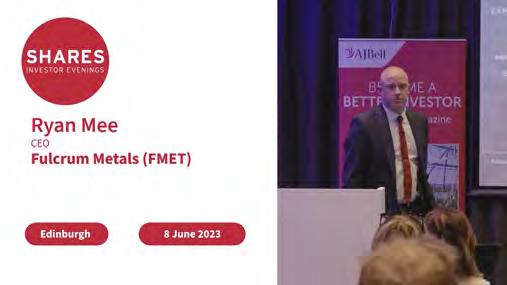

Serica Energy (SQZ) Mitch Flegg, CEO

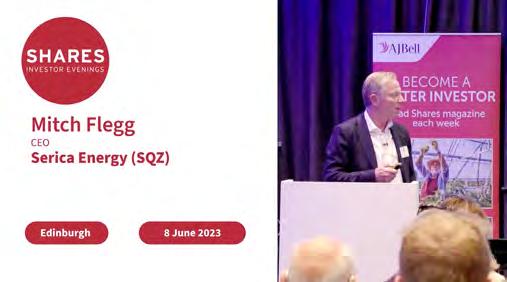
Serica Energy (SQZ) is a British independent upstream oil and gas company with operations focused on the UK North Sea, where our assets span the full cycle of exploration, development and production. Our main aim is to build a portfolio of assets which enables the Company to utilise its technical and commercial experience to add value to existing producing assets, as well as to explore and develop new reserves.
Sheffield Resources (SFX)



Bruce Griffin, Executive Chair
Sheffield Resources (SFX) is assembling a portfolio of mineral sands development and production assets. The core asset is Sheffield’s 50% interest in the Thunderbird project in which is fully funded with construction over 80% complete and less than 12 months from first production.
Fulcrum Metals (FMET)
Ryan Mee, CEO
Fulcrum Metals (LON:FMET) is a multi-commodity explorer with a diverse portfolio of gold, base metal, and uranium projects positioned close to mineral rich prospective areas and producing or near producing assets in Canada, a world-class mining destination.
the Shares website for the latest company presentations, market commentary, fund manager interviews and explore our extensive video archive.
CLICK TO PLAY EACH VIDEO SPOTLIGHT WEBINAR
VIDEOS
www.sharesmagazine.co.uk/videos
Reasons why the market could be too pessimistic about oil demand
Oil producers’ cartel OPEC+ may also have less influence than you think
‘You cannot buck the market’ is taken as axiomatic by many investors and it may be that Saudi Arabia is finding this out the hard way, as it attempts to bend the oil price to its iron will.
A fresh production cut from Riyadh, and an extension to the decreases initially agreed in April through 2024, is providing little support to oil prices in the wake of this month’s OPEC+ meeting in Vienna (4 Jun).
Nevertheless, from a risk management perspective, it could be unwise to forget about the price of crude altogether, or even assume it will stay stuck in the $70 to $80 per barrel range.
LONG AND SHORT OF IT
OPEC+’s influence is not as great as might first appear. Members of the 13-nation OPEC cartel and its 10 allies, such as Russia, control less than half of global oil production between them.
This may explain why oil traders are hardly running for cover even as Riyadh sanctions a cut in production of one million barrels of oil a day, or 1% of global output, from 1 July and gets OPEC+ to extend the 1.2 million-barrel-a-day cut announced in April into next year.
Reports of dissatisfaction among other OPEC members who are itching to increase output, notably Nigeria and Angola, may also be dampening the impact of the Saudi Arabian initiative.
An even bigger issue facing the oil price may be ongoing concerns over the possibility of a global recession, or at least a slowdown. In this context it is intriguing to note that equity markets seem content to price in a so-called ‘soft landing’ or even no recession at all. As such, either share buyers or


oil traders are going to be wrong at some stage.
If it is oil traders who are wrong, then heaven help them for two reasons. First, oil demand could come in higher than expected.
Second, traders have reportedly been building up short positions against crude, so if the price starts to go against them, they may need to buy oil to close out and that could give the commodity’s price a lift.
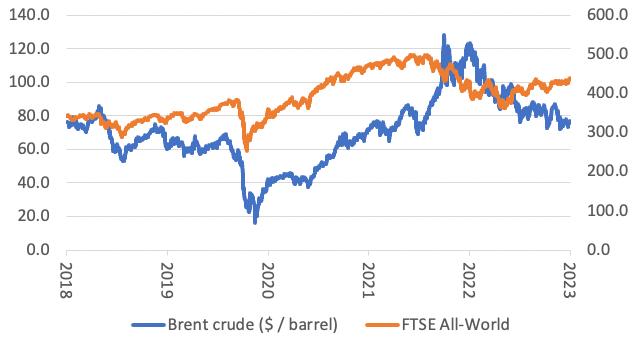
Once sentiment is so one-sided, it does not take much to get the price going in the other direction and while it is very hard for investors to gauge –other than by wading through the data provided by the Commodity Futures Trading Commission agency in the US – the impact of traders’

Russ Mould: Insightful commentary on market issues 22 | SHARES | 15 June 2023
Source: Refinitiv data
Oil and global equity prices are heading in different directions
positioning (and who is net long and net short) should never be underestimated.
LOW RESERVES
The fundamentals for oil may not be as bad as the market seems to think, either. It is rare for oil demand to drop, even during recessions, and whether we like it or not, hydrocarbons are likely to be a major source of energy for the globe for some time to come, as we seek to manage the transition toward a more renewable future and net zero by 2050.
It may therefore be unwise to underestimate demand, especially as America has run down its strategic reserves to just 355 million barrels, the lowest mark since 1983 and way below its 714-million-barrel capacity. For reasons of energy independence and national security it seems likely that the US will have to top up again at some stage.

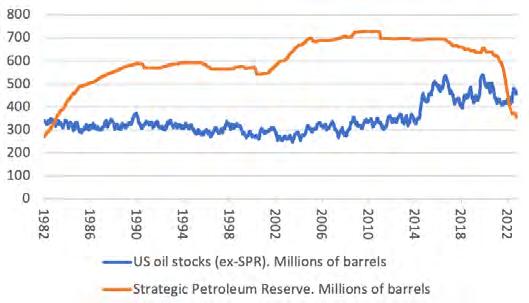
rising, there is a risk that there will not be enough supply available.
The result of that could in turn be sharp oil price increases, the last thing that traders currently seem to expect, although any such price spike could lead to the demand destruction (and decisive action to
Data from Baker Hughes shows that active rig numbers in the US are down by more than 10% from 2022’s highs, at 696, presumably in response to weaker oil and gas prices. The number of active rigs on a global basis is already down 8% from February’s high of 1,921. If demand does keep

secure new energy sources) that environmental campaigners crave, even if the price could be inflation.
That is something that neither central banks nor consumers nor equity investors will necessarily want to see, but while policymakers can sanction money printing, they cannot conjure up oil when it is needed, so their influence on crude is certainly less than that of OPEC+.
By Russ Mould Investment Director at AJ Bell

Russ Mould: Insightful commentary on market issues 15 June 2023 | SHARES | 23
Source: US Energy Information Administration
The US has run down its strategic oil reserves to near-40-year lows
Source: US Energy Information Administration
Source: Baker Hughes rig numbers are dwindling as oil and gas prices sag
The boom in US shale output could be slowing
Active
However, growth in shale oil production in the US appears to be slowing down, especially in the key Permian Basin, according to the Energy Information Administration, data which may inform the International Energy Agency’s forecasts that global hydrocarbon supply may grow more slowly than demand in 2023 (and demand is actually seen hitting a new all-time high).
Is the post-Covid luxury goods boom coming to an end?
The long-term structural growth story remains compelling, but cracks are appearing in the sector
Alongside the rally in mega cap tech names since January, one of 2023’s big themes is the popularity of global luxury goods stocks, with LVMH (MC:EPA), Richemont (CFR:SWX) and Hermès (RMS:EPA) hitting new share price highs amid an extraordinary boom in sales, supported by a demand rebound from China. LVMH even became the first European company to surpass $500 billion in market value.
But some parts of the sector have come off the boil more recently due to a post-Covid China reopening that appears to be losing momentum and softer sales in the US, which has been a major driver of luxury spending for the last three years.
Signs of cracks appearing in the luxury goods market, with diamond prices falling alongside the value of second-hand luxury watches in a market being flooded with supply, haven’t gone unnoticed by investors.
WHAT ARE COMPANIES SAYING?
Last month, British luxury goods brand Burberry (BRBY) reported a drop-off in sales in the Americas, while shares in high-end watches and jewellery seller Watches of Switzerland (WOSG) have tumbled more than 20% year-to-date after warning of a slowdown in growth.
Across the pond, shares in Capri (CPRI:NYSE), the owner of the Versace, Jimmy Choo and Michael Kors brands, are down 33% year-to-date and the company has cut its sales forecast amid weakening demand for its shoes and handbags.
Even luxury bulls will concede there is a cyclical aspect to industry demand linked to consumer confidence, but there is also a secular trend for affluent shoppers around the world to spend more time buying and enjoying luxury, premium and heritage-rich products.
The wealthy clientele of names like LVMH, the conglomerate behind Louis Vuitton, Christian
24 | SHARES | 15 June 2023 Sector Report: Luxury goods
LVMH (€) 20142016201820202022 0 200 400 600 800
•
Chart: Shares magazine
Source: Refinitiv
Dior, Tiffany, Givenchy and Hennessy cognac, are relatively insulated from cost-of-living pressures. Nevertheless, sales appear to be softening as even the well-heeled pare back spending, perhaps because the appetite for post-pandemic ‘revenge spending’ has been sated, or the rich are prioritising travel and experiences instead.
Morgan Stanley says: ‘Corporate messaging around performance in the US was relatively more subdued, albeit with management teams still pointing to a soft landing, with no dramatic slowing (on aggregate).’
However, in mainland China, Morgan Stanley says luxury management teams ‘alluded to strength in the higher-income consumer, and hence higher positioned brands. More encouragingly, we found companies upbeat on the return of incremental spend from the Chinese tourists, noting Chinese nationals have clearly started to travel and spend abroad, with Hong Kong and Macau raking in the first benefits.’
WHY INVESTORS LOVE LUXURY GOODS
Shares of the leading companies in the fragmented global luxury goods market are rarely cheap. The reason is that the businesses behind aspirational fashion brands or premium drink products are blessed with the pricing power and fat margins which are prized by investors.
These high margins enable them to generate oodles of cash which can be used to invest in marketing and brand building, fund acquisitions or pay progressive dividends.
Luxury stocks also offer exposure to structural drivers including the growth of the Chinese middle class as well as the unstoppable rise of digital sales and the ascendancy of internet-savvy Millennials and Generation Z.
One top money manager sitting on the sidelines for now is Freddie Lait, who manages the Latitude Horizon (BDC7CZ8) and Latitude Global (BMT7RH1) funds. ‘We like the luxury stocks,’ he informs Shares, ‘though we don’t own any at the moment but there’s definitely a few on our list. It is really a valuation point; they’ve done incredibly well. They are rare gems in the European market so they trade at a stark premium, but we keep models on three or four of those stocks and one day I’m sure we’ll reinvest back in.’
Lait believes it is ‘less likely’ luxury stocks will
be immune to a slowdown if we get one later this year, yet stresses they’ve been great stories for the last 20 years. ‘They’ve had very steady volume and price growth, they haven’t just been gouging their customers. Unless you have a strong view that the upper echelon of spenders is going to suffer particularly, I think they’ve probably got a reasonably good future ahead of them.’
How margins compare across luxury goods companies
WHICH NAMES ARE CLASSIFIED AS LUXURY GOODS STOCKS?
As the table shows, genuine luxury goods companies such as LVMH and Burberry, Cartierto-Montblanc brands-owner Richemont, Birkin bag maker Hermès (RMS:EPA) and Yves Saint Laurent-to-Gucci owner Kering (KER:EPA) generate gross margins in the high sixties-to-low
15 June 2023 | SHARES | 25 Sector Report: Luxury goods
FASHION, JEWELLERY Burberry 70.5% 20.5% Hermes 70.8% 40.5% Kering 74.7% 27.5% LVMH 68.4% 26.6% Richemont 68.9% 28.1% DRINKS Diageo 61.8% 23.9% Pernod-Ricard 61.4% 34.0% Remy Cointreau 71.3% 27.7% CARS Ferrari 48.0% 24.1% Company Gross Margin Operating Margin
Table: Shares magazine • Source: Company reports
Sector Report: Luxury goods
seventies percentage range, reflecting their ability to price coveted products materially ahead of inflationary costs.
WHICH FUNDS PROVIDE LARGE EXPOSURE TO THE LUXURY GOODS SECTOR?
One way to get diversified exposure to lots of different luxury names is through exchange-traded fund Amundi S&P Global Luxury ETF (LUXG).
This product tracks the S&P Global Luxury index which is made up of various companies involved in the provision or distribution of luxury goods or services, including LVMH as well as Richemont, Kering, Estée Lauder (EL:NYSE) and Pernod Ricard.
Another relevant product is GAM Multistock Luxury Brands Equity Fund (B637645), which has 8.6% of its portfolio in LVMH, 5.6% in Hermès, 5% in Ferrari (RACE:NYSE) and 4.9% in Richemont.
Buy and hold investor Nick Train from asset manager Lindsell Train likes companies with luxury, premium or aspirational brands. His Finsbury Growth & Income Trust (FGT) holds cognac and liqueur maker Remy Cointreau, Johnnie Walker-toDon Julio brands owner Diageo as well as Burberry.
The Zehrid Osmani-managed investment trust Martin Currie Global Portfolio (MNP) invests in Italian luxury apparel brand Moncler (MONC:BIT) as well as Ferrari, the high margin luxury carmaker able to price its products at a 25% to 75% premium to its nearest competitors with a focus on ultrapremium limited releases.
Premium drinks companies such as Diageo (DGE) and spirits rival Pernod Ricard (RI:EPA) are routinely lumped in with the broader luxury sector, since they offer exposure to similar themes. But as the data demonstrate, their gross margins are lower than what we’ll call ‘genuine’ luxury goods companies, with Remy Cointreau (RCO:EPA) an outlier.

As Lindsell Train fund manager James Bullock explains, this reflects product mix, price point and positioning, since Remy Cointreau is overwhelmingly in the cognac category and the majority of its revenues are ‘premium, with a big proportion of super-premium within that’.
Diageo has a respectable proportion of revenues from premium and above, ‘but not quite on the same level as Remy,’ stresses Bullock. ‘Premiumisation is a very powerful driver of gross profit, as Diageo picked out in its 2022 annual report. So, we appreciate Remy’s distinct skew to premium and super-premium and are highly supportive of Diageo’s stated goal of further premiumisation across its entire brand portfolio.’
Martin Currie Global Portfolio has a position in L’Oréal (OR:EPA), as does the Gerrit Smitguided Stonehage Fleming Global Best Ideas Equity Fund (BCLYMF3), whose top 10 also includes LVMH and lenses-to-sunglasses leader EssilorLuxottica (EL:EPA).

26 | SHARES | 15 June 2023
SHARES’ TOP STOCK PICKS
L’Oreal (OR:EPA) €399

Burberry (BRBY) £22.17

A pullback from all-time peaks at Burberry presents a buying opportunity in what star stock picker Nick Train describes as ‘one of a rarefied group of truly global luxury goods brands’ with an important position in the hearts of Asian consumers.
At these levels, the rainwear-to-leather goods expert swaps hands for 17.9 times forward earnings, a material discount to LVMH and Hermes. Results for the year to March 2023 showed profits, margins, free cash flow and dividends heading in the right direction with sales growth accelerating to 16% in the fourth quarter as growth rebounded in China.
Refocusing on ‘Britishness’ under chief executive Jonathan Akeroyd and new designer Daniel Lee, Burberry reported 19% growth in Asia Pacific for the fourth quarter.
Though the market was spooked by softness in the Americas, Burberry strutted in with doubledigit growth in Japan and the EMEIA (Europe, Middle East, India, Africa) region. Often rumoured as a bid target, Burberry’s history as a quoted company is impressive, having listed back in 2002 at a share price of circa 200p and with annual sales of circa £500 million. Sales topped £3 billion last year and are forecast to exceed £3.3 billion in the year to March 2024.
Paris-based personal care company L’Oreal’s longrun share price chart is a thing of beauty. And while a prospective price to earnings ratio of 33 appears punchy, it is actually cheap relative to L’Oreal’s trend PE history and is merited by the quality of the world’s largest cosmetics company’s model, strong margins and brand power.
The haircare, makeup and fragrances powerhouse demonstrated its pricing power in the first quarter of 2023 by generating betterthan-expected 13% like-for-like sales growth and reporting a ‘spectacular performance’ in emerging markets.
Stonehage Fleming Global Best Ideas Equity Fund manager Gerrit Smit believes L’Oreal is ‘superbly positioned’ within the dermatological beauty market, with consumers eager to slow the ageing effects on their skin by splashing out on products such as La Roche-Posay.
A robust balance sheet is also enabling L’Oréal to complement organic growth with acquisitions such as Australian skincare brand Aesop, recently purchased in a $2.5 billion deal on approximately 1.4 times net asset value.
By James Crux Funds and Investment Trusts Editor

15 June 2023 | SHARES | 27 Sector Report: Luxury goods
Burberry (p) 20142016201820202022 0 1,000 2,000 Chart: Shares magazine • Source: Refinitiv L'Oreal (€) 20142016201820202022 0 200 400 Chart: Shares magazine • Source: Refinitiv
Five key ratios to analyse a stock in five minutes
Investing in good companies at good prices should be the aim of every investor
Quickly grasping the fundamental strengths and weaknesses of a company can save time when you are researching stocks. Narrowing the universe to a small set of names means you can be more focused and only have to dig deeper for the most promising investment candidates.
This article reveals five ratios that can be used to get a quick understanding of the fundamental attractions of any company in five minutes.
1. RETURN ON EQUITY
Return on equity is a way to measure the performance of a company – you divide net income by shareholder equity, the latter calculated by subtracting total liabilities from total assets.
For example, pharmaceutical firm GSK (GSK) has equity of £10.59 billion according to its last audited balance sheet on 31 December 2022. This is calculated by subtracting total liabilities of £49.55 billion from total assets of £60.14 billion.
Net income in 2022 from continuing operations was £4.46 billion, therefore the return on equity was 42.1% (4.46/10.59).
With financial ratios it is more important to look at trends because any single year can be distorted by various accounting adjustments. Over the last five years GSK has delivered an average return on equity of 62%.
A decent business will have a return on equity of at least 10% and north of 15% is considered a good quality business, assuming it doesn’t deploy too much debt.
2. GEARING
Before getting too carried away with GSK’s
HOW TO CALCULATE THE FIVE RATIOS
Return on equity
= (net income / equity) x 100
Gearing
= (net debt / equity) x 100
Gross profit to assets
= (gross profit / total assets) x 100
Free cash flow to sales
= (free cash flow / sales) x 100
Price to earnings
= share price / earnings per share
impressive return on equity it is important to consider how much debt the company is carrying.
A useful ratio to consider is net debt to equity which is also referred to as the gearing ratio.
The attraction of debt financing is that it increases return on equity, everything else
Education: Analysing stocks 28 | SHARES | 15 June 2023
being equal.
However, increased gearing can be potentially dangerous for shareholders if taken too far as it gives more influence to banks and debt holders which have priority over shareholders.
GSK employs net debt of around £13 billion which is funding some of its assets on top of the £10.59 billion of equity funding. This implies a net gearing ratio of 123% (13/10.59).
In most cases, gearing above 75% suggests some caution should be applied when interpreting return on equity and assessing general balance sheet strength. In GSK’s case, the business tends be highly cash generative, so the firm can afford to run with higher gearing.
In addition, the company owns around £3 billion of shares in Haleon (HLN), the consumer healthcare unit spun out in 2022. These shares are likely to be sold in time. This means the underlying gearing ratio is not as high as the headline ratio.
3. GROSS PROFIT TO TOTAL ASSETS
The idea of this ratio is to measure gross profit as a percentage of total assets. A high ratio (above 40%) suggests a higher quality business.
Research by Robert Novy-Marx of the University of Rochester found the gross profit to assets ratio was more predictive for share price returns than widely used earnings and cash flow measures.
Firms with high ratios generated significantly higher share price returns than lower quality firms despite having higher valuations. Although a simple measure it is useful because gross profit and total assets are less susceptible to accounting manipulation.
Taking each side of the ratio in turn, gross profit is a basic measure of a company’s profitability. It is calculated by subtracting cost of sales from sales. Total assets represent all the assets employed in the business and can be found from the balance sheet.
Let’s look at GSK again. Gross profit in 2022 was £20.85 billion and total assets were £60.15 billion which means GSK has a gross profit to total assets ratio of 35% (20.85/60.15).
A decade ago, the ratio was closer to 45% which suggests the company has not performed
as effectively in recent years. This is one of the criticisms made by activist investors including Elliott.
4. FREE CASH FLOW TO SALES
The reason for using the free cash flow to sales ratio is to identify successful and profitable businesses which tend to generate lots of cash.
Companies which can convert a higher proportion of their annual sales into cash are more valuable to shareholders than those which struggle.
The simple reason is that it gives companies more flexibility to use the cash for shareholders’ benefit. It can be used to pay out dividends, reinvest in the business to drive growth or make acquisitions.
Firms which generate more cash than they need to invest in the business can also pay down their debts which increases shareholder value.
Free cash flow can be defined as cash generated from operations minus capital expenditures. Cash from operations can be found on the cash flow statement.
Not all companies provide the same items on a cash flow statement, and it can sometimes appear a little intimidating. So, a simpler method is to look at the profit and loss statement with which most investors are more familiar.
Start with net profit and add back two non-cash items, depreciation and amortisation, to arrive at operating cash.
GSK generated £4.92 billion of net profit in 2022 while depreciation and amortisation totalled £2.43 billion which means operating cash was £7.35 billion.
Capital expenditures were £2.25 billion which means free cash flow was £5.1 billion (7.35-2.25). Sales were £29.3 billion, therefore GSK’s free cash to sales ratio in 2022 was 17.4% (5.1/29.3).
A free cash to sales ratio above 15% represents a quality business.
5. PRICE TO EARNINGS
One of the most popular ratios used to gauge a share’s attractiveness is the ratio of the share price to the forecast earnings per share for the year ahead, also known as the PE. The ratio is useful because all companies with positive earnings can
Education: Analysing stocks 15 June 2023 | SHARES | 29
GSK versus AstraZeneca ratios
be compared using this method.
The key factors driving different PEs come down to expected growth in earnings and return on equity. Higher growth and higher return on equity companies should trade on higher PE ratios.
But remember PEs can also move up and down due to investor sentiment and become divorced from fundamentals. This can throw up some interesting opportunities. Let’s compare GSK to AstraZeneca (AZN) to illustrate this effect.
GSK is forecast to deliver 146p per share of earnings for the year to 31 December 2023 and 155p in 2024. A share price of £13.91 implies a forward PE ratio of 9.5 times for 2023 and 9 times for 2024. AstraZeneca trades on forward PE of 19.8 for 2023 and 17.1 times for 2024.
That is a big difference, but is it reasonable?
One way of answering the question is to look at potential shareholder returns and compare them to the PE ratio.
A rough proxy for estimating future total shareholder return is to take the current dividend yield and add expected growth in earnings per share. In theory the PE should reflect all future earnings, but in practice estimates are only available for two or three years ahead.
GSK has a yield of 4.2% and management is
guiding for low-to-mid double-digit EPS growth per year over the next five years.
Conservatively assuming growth at the lower end of the range (12%) and adding the current yield implies total shareholder returns in the region of 16% a year (4.2+12).
Meanwhile, AstraZeneca is guiding for 2023 EPS to grow by high single digit to low doubledigit percentages while the dividend yield is 2.1%. Analysts forecast EPS growth of 15%.
Giving AstraZeneca the benefit of the doubt because it has executed much better than GSK in recent years, and assuming it can grow EPS at 15% a year, the expected shareholder total return is 17% a year.
In other words, expected total returns for the two companies are roughly the same except investors can buy GSK shares at half the PE.
There are no guarantees that GSK shareholders will do better than AstraZeneca’s over the next five years, but the risks compared with the potential rewards looks more favourable.
By Martin Gamble Education Editor

Education: Analysing stocks 30 | SHARES | 15 June 2023 15 June 2023 | SHARES | 30
GSK 62% 123% 35% 17.4% 9.5 AstraZenca 11.5% 69.7% 37% 10.8% 19.8 Five average return on equity Net gearing Gross profit to total assets Free cash flow to sales Price to earnings (2023)
Table: Shares magazine • Source: Stockopedia, Refinitiv, Shares
The range of products tracking investment themes is growing but they are not all created equal
Themes can be a powerful driver of investment returns as followers of the recent proliferation of AI (artificial intelligence) as a hot topic in the financial markets and beyond could attest.
The fast-growing thematic ETF (exchange-traded fund) universe provides a straightforward way to invest in various themes, including AI. Typically, the focus is on long-term structural changes (often called megatrends), affecting society.
Examples include investments tied to environmental, social and corporate governance (ESG) factors, the robotics and automation industry, blockchain technology and semiconductors.

STRONG INVESTOR INTEREST
Investment interest in thematic ETFs remains strong according to industry
information provider Trackinsight’s Global ETF Survey 2023.
More than 40% of those surveyed said they would increase their thematic ETFs allocation over the next few years because of diversification, strategic allocation, liquidity, costs and the underlying index methodology.
Other reasons why investors have been piling into thematic ETFs this year include interest in technological innovation and environmental change, according to the Trackinsight survey.
More than 90% of respondents declared either being invested in (68%) or interested in (24%) thematic ETFs which address disruptive technological innovations.
Environmental strategies were also popular with 81% of respondents interested and invested in this area.
FOCUS ON GENUINE TRENDS NOT INVESTMENT FADS
A danger associated with investing in thematic ETFs is that by the time a product has been created to capture a hot
15 June 2023 | SHARES | 31 Exchange-Traded Funds: Thematic funds
Fad or genuine trend?
What you need to know before investing in a thematic ETF
Distinguish between fads and investment bubbles and genuine longterm trends”
Exchange-Traded Funds: Thematic funds

theme, the easy gains will already have been made and potentially it may start to lose momentum. On the flipside if a theme is too niche, then any ETF set up to track it may struggle to attract assets, be harder to buy and sell, have higher costs and ultimately might end up being shut down.
Pedro Palandrani, director of research at Global X ETFs, says if investors are going to invest in thematic ETFs it is best to take a long-term approach ‘making market timing less of a factor’.
Palandrani also says identifying a thematic opportunity early on can help an investor to mitigate potential losses. To which the counter argument might be, in the initial stages of a theme there may not be a relevant product available to a retail investor.
Investors need to distinguish between fads and investment bubbles and genuine long-term trends. Doing so is not necessarily an easy task.
Palandrani says: ‘We believe long-term investors should prioritise identifying structural themes rather than cyclical ones. Given the longer-term nature of these themes and their disruptive nature, we have found that structural themes can be less dependent on timing entry and exit points and can be significantly more powerful in magnitude.’
The table shows the performance of US-listed Global X thematic ETFs over three years. The average performance of these products is only just in positive territory and there is a wide dispersion between the best performing product (offering exposure to the lithium and battery technology space) and the big decline for the cannabis-related strategy.
In WisdomTree’s latest quarterly thematic report for Europe, the global ETF provider said that over the past two years thematic ETFs had experienced bouts of volatility across many themes, ‘especially in technology-focused thematics’ and ‘longer-duration assets more sensitive to interest rate hikes’.
But these themes have started to make a recovery this year. If we look at WisdomTree’s top inflows in Europe ETFs year-to-date we can see that technology-focused thematic strategies lead the pack, with semiconductors and blockchain posting the biggest gains across the themes. WisdomTree’s ‘Rise of the Middle Class’ and ‘Millennials & Gen Z’ themes have also resonated.
Performance of Global X ETFs
32 | SHARES | 15 June 2023
Global X Lithium & Battery Tech ETF 30 Global X U.S. Infrastructure Development ETF 24 Global X Autonomous & Electric Vehicles ETF 21 Global X Internet of Things ETF 13 Global X Artificial Intelligence & Technology ETF 11 Global X Cybersecurity ETF 9 Global X Robotics & Artificial Intelligence ETF 6 Global X Aging Population ETF 4 Global X Millennial Consumer ETF 4 Global X Health & Wellness ETF 3 Global X Video Games & Esports ETF −1 Global X Cloud Computing ETF −2 Global X Social Media ETF −3 Global X Renewable Energy Producers ETF −4 Global X Thematic Growth ETF −4 Global X E-commerce ETF −8 Global X Genomics & Biotechnology ETF −10 Global X FinTech ETF −12 Global X Cannabis ETF −51 Average performance 2 MSCI World 34 ETF Three-year annualised performance (%) All
market price, Data
of 05/31/23 Table: Shares magazine • Source: Global X
performance quoted below reflects
as
Year-to-date top five inflows in Europe ETFs
WHAT NEXT FOR THEMATIC ETFS?
‘Thematic ETFs related to technology and AI will continue to be popular with investors this year,’ predicts Pierre Debru, head of quantitative research and multi-asset solutions for WisdomTree Europe.
Dina Ting, head of global index portfolio management at Franklin Templeton ETFs, agrees. Ting says: ‘There has been growing investor confidence in the intersection between AI and mixed reality applications that appears to be benefiting the metaverse theme. As Nvidia (NVDA:NASDAQ) is a top portfolio holding in our metaverse fund (Franklin Metaverse UCITS ETF (METE)), its strong earnings have also boosted performance.

‘Furthermore, year-to-date, our Franklin S&P Paris Aligned Climate UCITS ETF (500P) has outperformed the broader market. The fund is a cost-effective strategy focused on mitigating climate-risk exposure and capturing the growth

Year-to-date top five outflows in Europe ETFs
opportunities arising from the low carbon transition through alignment with the goals of the Paris Climate Agreement.’
Ting says thematic ETFs give investors a chance ‘to align their values and convictions with their investments’.
‘With thematic ETFs, investors can look beyond more traditional geographic and sector groupings for diversification and targeted outcomes. Thematic ETFs are popular and easy-to-use vehicles for tactical asset allocation purposes aimed at generating alpha in a portfolio.
‘They can be used to capture growth in a secular trend that may be occurring over a longtime horizon, but they are also flexible enough to be used for shorter-term strategies,’ adds Ting.
By Sabuhi Gard Investment Writer
15 June 2023 | SHARES | 33
Exchange-Traded Funds: Thematic funds
Equality, Inclusion & Diversity (88 million) Rise of China Tech (60 million) Sustainable Energy Production (50 million) Cybersecurity (40 million) Agriculture (12 million) ($ m)
Table: Shares magazine Source: WisdomTree, Morningstar, Bloomberg. All data as of 30/04/2023 and based on WisdomTree's internal classification of thematic funds. Performance is based on monthly returns from Bloomberg and Morningstar
Semiconductors 260 million Artificial Intelligence & Big Data 250 million Rise of the Middle Class 210 million Sustainable Resource Management 200 million Natural Resources 140 million ($ m)
Table: Shares magazine • Source: WisdomTree, Morningstar, Bloomberg. All data as of 30/04/2023 and based on WisdomTree's internal classification of thematic funds. Performance is based on monthly returns from Bloomberg and Morningstar
technology and AI will continue to be popular with investors this year”
27 JUNE 2023
NOVOTEL TOWER BRIDGE

LONDON EC3N 2NR
Registration and coffee: 17.30
Presentations: 18.00
During the event and afterwards over drinks, investors will have the chance to:
• Discover new investment opportunities
• Get to know the companies better
• Talk with the company directors and other investors
Sponsored by
Reserve your place now!
COMPANIES PRESENTING
GOOD ENERGY GROUP (GOOD)

A supplier of 100% renewable power and an innovator in energy services. It has long term power purchase agreements with a community of 1,700 independent UK generators. Since it was founded 20 years ago, the company has been at the forefront of the charge towards a cleaner, distributed energy system.
HERCULES SITE SERVICES (HERC)

With four divisions within their organisation, they have the capability to supply skilled labour, deliver complete civils projects, hire out our state-of-the-art suction excavators and other plant, and provide digital solutions for construction recruitment and workforce management.
MANOLETE PARTNERS (MANO)

A specialist insolvency litigation financing company. We fund or buy insolvency claims. We work with Insolvency Practitioners and their lawyers to maximise returns to creditors.
STRATEGIC EQUITY CAPITAL (SEC)
A specialist alternative equity trust. Actively managed, it maintains a highlyconcentrated portfolio of 15-25 highquality, dynamic, UK smaller companies, each operating in a niche market offering structural growth opportunities.

Register for free
www.sharesmagazine.co.uk/events
now
LIVE EVENT
Can a retrospective lifetime allowance assessment be made once in drawdown?

One individual has their eye on the next general election and whether we could see yet more changes to pension rules

With the abolition of the lifetime allowance this year by Jeremy Hunt, will a crystallisation event take place when I decide to draw my pension early next year, post-April?
If the pot is crystallised, will it be exempt from an assessment should a different party be elected and reinstate the lifetime allowance? I am considering crystallising my pot to insure against what may or may happen at the next general election and see crystallising as key to making my decision.
It is not my intention to start drawing on my pension, merely just to crystallise it by commencing drawdown. I guess the question is: can a retrospective lifetime allowance assessment be made after a pension is in drawdown?
David in Doncaster
Chancellor Jeremy Hunt, in his March Budget, announced plans to abolish the lifetime allowance in April 2024. The lifetime allowance remains in place for the 2023/24 tax year and is set at £1,073,100, although some people holding lifetime allowance ‘protection’ may have been entitled to more than this amount.
However, while the lifetime allowance remains in place in 2023/24, the lifetime allowance charge has been removed. This is a sticking plaster until the government figures out what the limits on pension benefits will look like from April 2024.
Providers are still required to record ‘benefit crystallisation events’ behind the scenes. These events include taking your tax-free cash, entering drawdown and buying an annuity.
Your maximum tax-free cash lump entitlement is capped at 25% of however much lifetime allowance
you’ve got left. For example, if you haven’t used any lifetime allowance, your maximum lump sum will be £268,275 (i.e. 25% of £1,073,100).
In terms of how the rules will function in 2024 and beyond, we’re waiting on a consultation later on in the year to find out more.
Governments do not generally make retrospective changes to pensions. However, the decision to scrap the lifetime allowance, combined with Labour’s pledge to reverse the decision to scrap it is without precedent.
It is possible a Labour government would attempt to reintroduce the lifetime allowance framework that existed before 6 April 2023, but it could feasibly make changes to capture any actions it feels were designed to dodge its policy intention in the interim.
It is sensible to deal with the tax rules as you see them, rather than trying to make decisions today to avoid some possible future tax system of which we have no detailed knowledge.
There are also consequences to crystallising your pot. If, for example, you have a fund worth less than £1,073,100 and crystallise the entire pot, any growth on the fund will not generate extra tax-free cash entitlement. If left uncrystallised, your tax-free cash entitlement could continue growing up to the £268,275 maximum.
Decisions involving the lifetime allowance are complicated, so consider financial advice.
DO YOU HAVE A QUESTION ON RETIREMENT ISSUES?
Send an email to asktom@sharesmagazine.co.uk with the words ‘Retirement question’ in the subject line. We’ll do our best to respond in a future edition of Shares
Please note, we only provide information and we do not provide financial advice. If you’re unsure please consult a suitably qualified financial adviser. We cannot comment on individual investment portfolios.
Ask Tom: Your retirement questions answered 15 June 2023 | SHARES | 35
Tom Selby, AJ Bell Head of Retirement Policy, says:
New rules from the regulator will mean that from December this year you will get an email or letter from your pension provider if you have a lot of cash in your pension.
There are a few criteria you’ll have to meet: that more than 25% of your pension is in cash, that this figure is more than £1,000 and that you are more than five years from normal minimum pension age, which is 55 for most people. Your pension provider will have to assess this every three months, sending out a notification if you’ve met the criteria for six months.
WHAT’S IN THE LETTER?
Your pension provider will tell you about your cash levels, provide you with a calculation about how inflation is eating away at your cash, and prompt you to think about your investments and whether you need to move some of that cash into other assets. Once it has sent the letter it will do so again every 12 months that you meet the criteria.
You don’t have to take any action off the back of the email or letter and you don’t have to reply to your provider – it’s more intended as a prompt for you to think about your cash levels and whether they are right for you.
HOW MUCH CASH SHOULD YOU HOLD?
That sparks the next question, how much cash is the right amount to have in your pension? We’ve previously talked about the right levels of cash to hold generally, but the parameters are a bit different when it comes to your pension, particularly because cash in pensions doesn’t earn very much, if any, interest.
Everyone will usually have some of their pension in cash, to meet the fees and charges from their pension provider.
But generally it’s not a good idea to have large sums in cash, particularly over the long term. Here’s an example: A pension pot worth £100,000 that is always 75% invested and 25% in cash would be worth £235,500 after 20 years, assuming no further

Personal Finance: Pensions 36 | SHARES | 15 Jube 2023
The financial regulator wants people under 50 to understand the benefits of being invested in the markets
Why your pension provider will soon warn you about holding too much cash
Based on £100,000 invested with investments generating 5% a year return with cash generating 2.5% a year, after charges.

Chart: Shares magazine • Source: Shares magazine
contributions and that the investments generate 5% annual return while cash generates 2.5% a year, after charges.
If instead that money was 100% in investments, earning 5% a year, the £100,000 pot would grow to just over £265,300 after 20 years – almost £30,000 more.
WHY INVESTORS STILL LIKE TO HOLD SOME CASH
There are a few reasons why you might have more cash than a basic amount.
You’re doing it as a strategic move
Some investors might want to keep money in cash if they think markets are quite expensive at that point in time and they want to keep some cash on the sidelines.
They might have sold down some investments to lock in gains and not want to deploy that money back into markets.
While it’s a tricky game to try to accurately time the markets, it’s also fair to strategically keep some money on the side if you think markets or certain investments are too pricey at the moment and you’re waiting for them to fall.
You want less risk in your portfolio
Whether you’re feeling nervy about markets or you just want to dial down the risk in your pension, you might decide to increase your cash levels temporarily. There’s nothing wrong with this so long as it’s a considered decision, and that you review it regularly.
Many people end up with their pension’s cash levels gradually rising over the years with no intention behind it, and that can be problematic as you could be needlessly missing out on potentially higher investment growth.
While cash isn’t going to beat inflation over the long term and isn’t going to grow your wealth by a lot, it’s fine if you want some no-risk assets in your portfolio. But it’s also worth considering whether there are some other, lower-risk assets you could invest in instead of leaving the money in cash.
You’re nearing the time when you want to access your pension
Previously, pensions used to be gradually moved into lower and no-risk assets as people neared retirement, with a view that they would then use that pot of money to buy an annuity. Now, most people keep their pension money invested and draw on the money as they need it.
However, you’ll likely still want to de-risk your assets as you near retirement to ensure they aren’t exposed to market falls just when you need access to the money.
Everyone will have a different timeline, depending on their financial circumstances and risk tolerance, but for many this de-risking could start many years before retirement.
By Laura Suter AJ Bell Head of Personal Finance

Personal Finance: Pensions 15 June 2023 | SHARES | 37
Year 1 Year 20 100,000 150,000 200,000 £250,000 75% investments / 25% cash 100% investments £29,800 difference
problem
cash
The
with too much
WHO WE ARE
EDITOR: Daniel Coatsworth @Dan_Coatsworth
DEPUTY EDITOR: Tom Sieber @SharesMagTom

NEWS EDITOR: Steven Frazer @SharesMagSteve
FUNDS AND INVESTMENT
TRUSTS EDITOR: James Crux @SharesMagJames

EDUCATION EDITOR: Martin Gamble @Chilligg
COMPANIES EDITOR: Ian Conway @SharesMagIan






INVESTMENT WRITER: Sabuhi Gard @sharesmagsabuhi

CONTRIBUTORS: Danni Hewson
Laith Khalaf
Russ Mould
Tom Selby
Laura Suter
Shares magazine is published weekly every Thursday (50 times per year) by AJ Bell Media Limited, 49 Southwark Bridge Road, London, SE1 9HH. Company Registration No: 3733852.
All Shares material is copyright. Reproduction in whole or part is not permitted without written permission from the editor.
Shares publishes information and ideas which are of interest to investors. It does not provide advice in relation to investments or any other financial matters. Comments published in Shares must not be relied upon by readers when they make their investment decisions. Investors who require advice should consult a properly qualified independent adviser. Shares, its staff and AJ Bell Media Limited do not, under any circumstances, accept liability for losses suffered by readers as a result of their investment decisions.
Members of staff of Shares may hold shares in companies mentioned in the magazine. This could create a conflict of interests. Where such a conflict exists it will be disclosed. Shares adheres to a strict code of conduct for reporters, as set out below.
1. In keeping with the existing practice, reporters who intend to write about any securities, derivatives or positions with spread betting organisations that they have an interest in should first clear their writing with the editor. If the editor agrees that the
reporter can write about the interest, it should be disclosed to readers at the end of the story. Holdings by third parties including families, trusts, selfselect pension funds, self select ISAs and PEPs and nominee accounts are included in such interests.
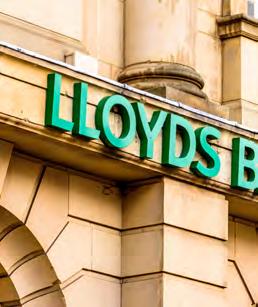
2. Reporters will inform the editor on any occasion that they transact shares, derivatives or spread betting positions. This will overcome situations when the interests they are considering might conflict with reports by other writers in the magazine. This notification should be confirmed by e-mail.
3. Reporters are required to hold a full personal interest register. The whereabouts of this register should be revealed to the editor.
4. A reporter should not have made a transaction of shares, derivatives or spread betting positions for 30 days before the publication of an article that mentions such interest. Reporters who have an interest in a company they have written about should not transact the shares within 30 days after the on-sale date of the magazine.

Index 38 | SHARES | 15 June 2023
ADVERTISING Senior Sales Executive Nick Frankland 020 7378 4592 nick.frankland@sharesmagazine.co.uk Main Market AstraZeneca 7, 30 Barclays 5 BP 17 Burberry 24 Diageo 26 DiscoverIE 13 Diversified Energy Company 18 EnQuest 17 GSK 28 Gym Group 8 Haleon 29 Harbour Energy 17 HSBC 5 InterContinental Hotels11 Lloyds 5 NatWest 5 Shell 17 Tesco 9 Virgin Money 5 Watches of Switzerland24 Whitbread 11 AIM Eco Atlantic Oil & Gas19 Kistos 17 Next 15 12 Orcadian Energy17 Serica Energy 17 Overseas shares Apple 15 Capri 24 Chinook Therapeutics7 EssilorLuxottica 26 Estee Lauder 26 Fedex 10 Ferrari 26 Hermes 24 Kering 26 L'Oreal 26 LVMH 24 Merck 7 Microsoft 15 Moncler 26 Netflix 8 Novartis 7 Nvidia 33 Pernod Ricard 26 Pfizer 7 Prometheus Biosciences7 Remy Cointreau 26 Richemont 24 Seagen 7 Talos Energy 17 Investment Trusts Finsbury Growth & Income Trust 26 International Biotechnology Trust 7 Martin Currie Global Portfolio 26 RTW Venture Fund7 Syncona 7 Funds GAM Multistock Luxury Brands Equity Fund 26 Latitude Global 25 Latitude Horizon25 Stonehage Fleming Global Best Ideas Equity Fund 26 ETFs Amundi S&P Global Luxury ETF 26 Franklin Metaverse UCITS ETF 33 Franklin S&P Paris Aligned Climate UCITS ETF 33 WisdomTree Softs6 Worldwide Healthcare Trust 7
DISCLAIMER





































 By Tom Sieber Deputy Editor
By Tom Sieber Deputy Editor




































